The Integration Paradox
First Results of a Meta-Analysis &
Proposal of a New Experimental Design
Merlin Schaeffer & Judith Kas (WZB)
2023-04-21
Tocqueville's Paradox

The hatred that men bear to privilege increases in proportion as privileges become fewer and less considerable,
[...]
the love of equality should constantly increase together with equality itself [...].-- Alexis de Tocqueville (2015 [1840])
Tocqueville's Paradox

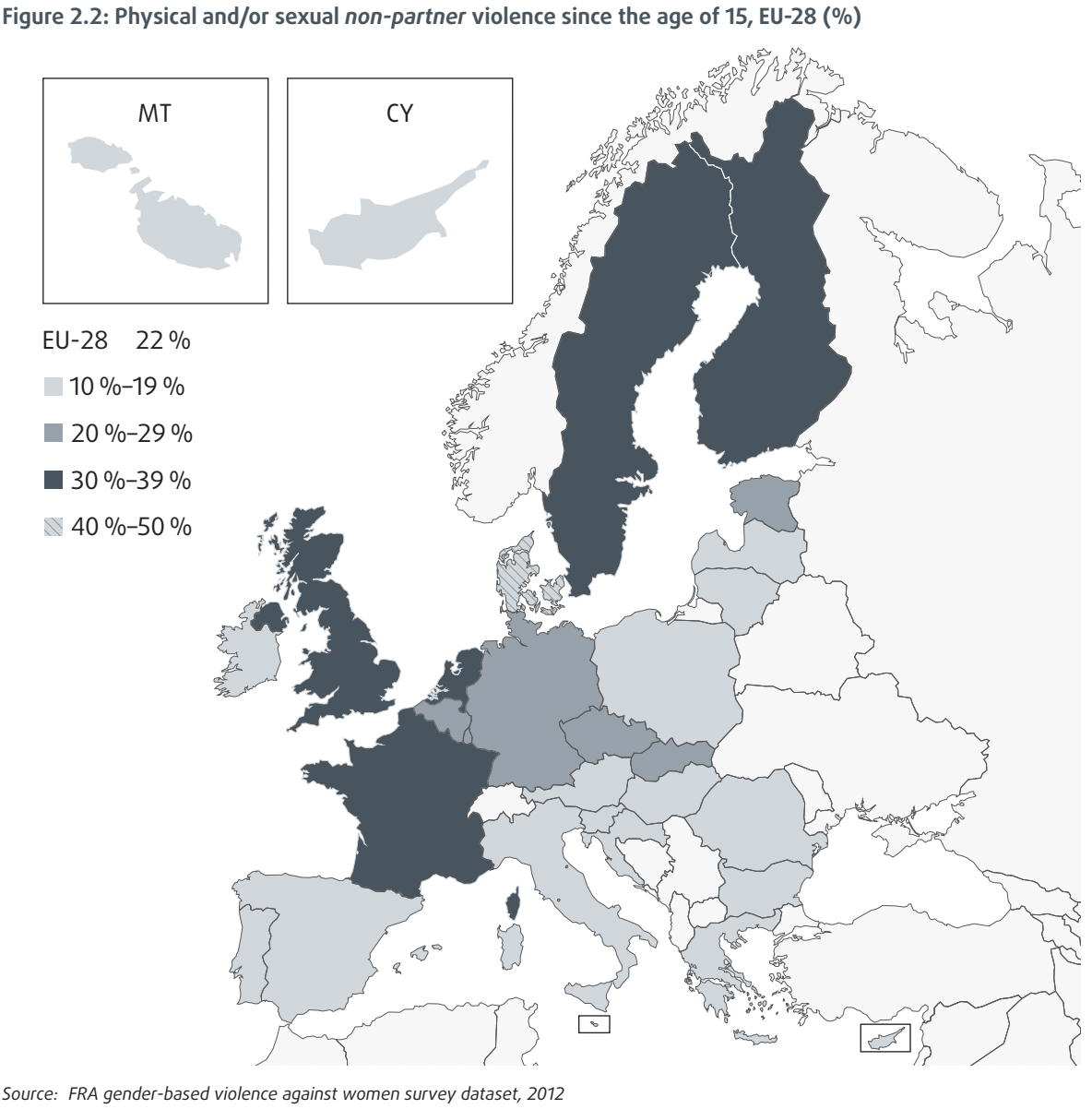
Source: European Union Agency for Fundamental Rights. (2014)
Tocqueville's Paradox

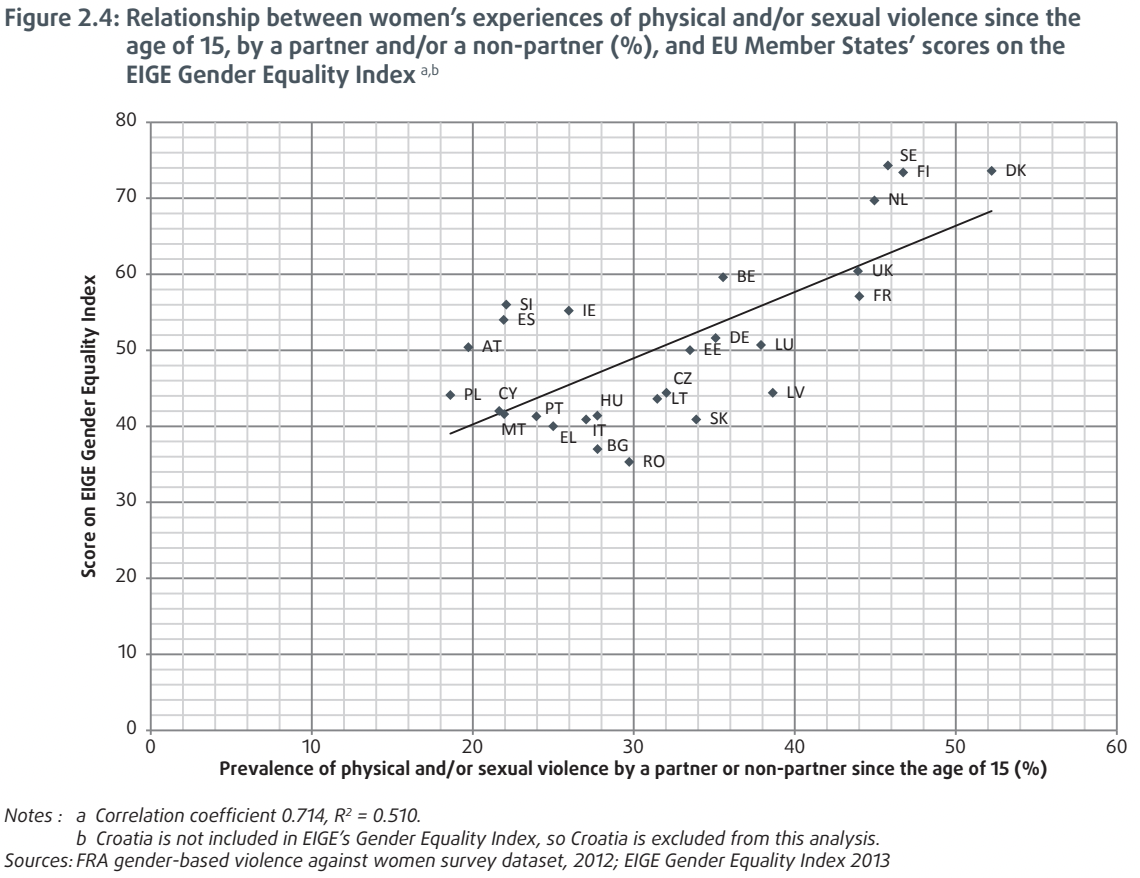
Source: European Union Agency for Fundamental Rights. (2014)
An integration paradox?
 Single family home in Berlin's suburb Rudow
Single family home in Berlin's suburb Rudow
Do immigrants and their descendants who established themselves among the middle-class mainstream report
less or more
discrimination than those who remain at the margins of society?
An integration paradox?
 Single family home in Berlin's suburb Rudow
Single family home in Berlin's suburb Rudow
[...] greater familiarity with the culture and language and some economic advancement can lead to greater consciousness of the reality of discrimination.
-- Portes, Parker, and Cobas (1980)
The integration paradox Synthesized theoretical model
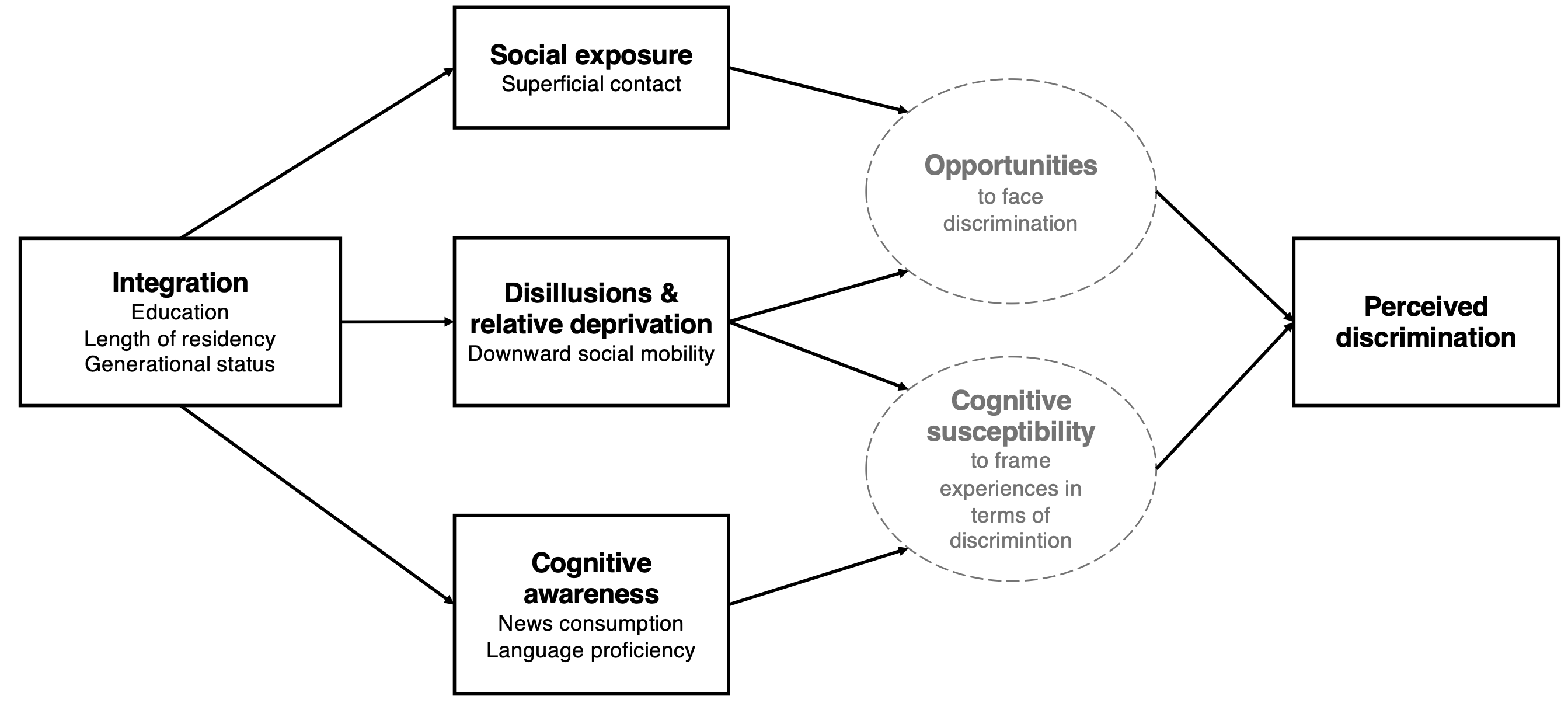
Meta-analysis Which reliable patterns has the literature produced so far?
Sample definition
- Outcome: perceived (ethnic) discrimination.
- Population: Immigrants, descendants of immigrants, or members of an ethnic, religious, or racial minority.
- Correlation or regression coefficient & associated inference statistic: Perceived discrimination and one of the following types of indicators of immigrant integration:
- Education, length of residence or generational status,
- Labor market attainment (e.g., income), exposure to persons of native-born parents (e.g., neighborhood share),
- Indicators of familiarity with public discourse (e.g., news media consumption),
- Indicators of (downward) social mobility
- Published in English & no MA theses.

Meta-analysis Which reliable patterns has the literature produced so far?
Sample definition
- Outcome: perceived (ethnic) discrimination.
- Population: Immigrants, descendants of immigrants, or members of an ethnic, religious, or racial minority.
- Correlation or regression coefficient & associated inference statistic: Perceived discrimination and one of the following types of indicators of immigrant integration:
- Education, length of residence or generational status,
- Labor market attainment (e.g., income), exposure to persons of native-born parents (e.g., neighborhood share),
- Indicators of familiarity with public discourse (e.g., news media consumption),
- Indicators of (downward) social mobility
- Published in English & no MA theses.
Sampling
- 766 non-duplicate studies from WoS & Google Scholar via search string, 7 April 2021:
("integration paradox" OR "Paradox of Integration") AND discrimination
Sample Cleaning & pre-reg training
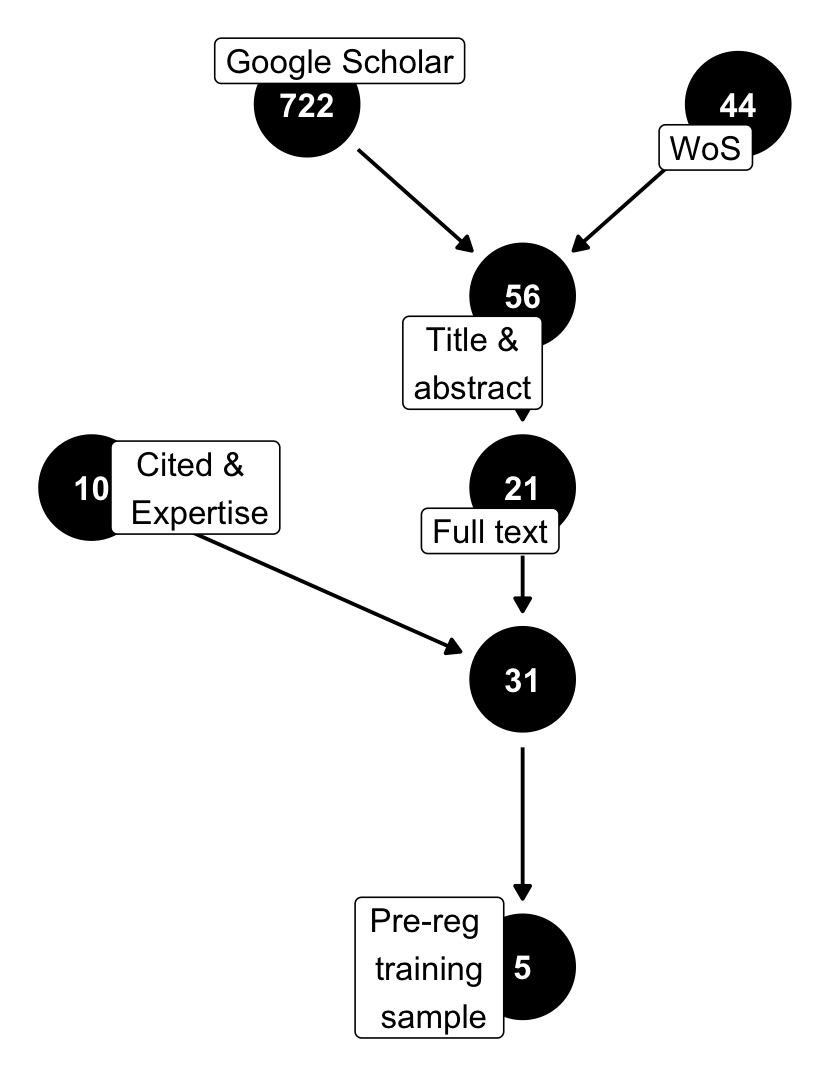
Sample Cleaning & pre-reg training

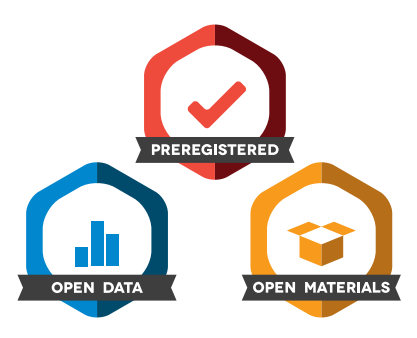
Coding
Outcome
ρyx⋅z=Cov(ex⋅z,ey⋅z)SDex⋅zSDey⋅z,=t√t2+df.
Source: Gustafson (1961)
Disadvantages: ρyx⋅z depends on z & is probably not accurate for estimates from GLMs.
Coding
Outcome
ρyx⋅z=Cov(ex⋅z,ey⋅z)SDex⋅zSDey⋅z,=t√t2+df.
Source: Gustafson (1961)
Disadvantages: ρyx⋅z depends on z & is probably not accurate for estimates from GLMs.
Predictors
- Original predictor:
- Broad indicators of integration
- Education
- Generation
- Length of residence
- Social exposure
- Contact to mainstream members
- Labor market attainment
- Awareness
- Media consumption
- Language skills
- Disillusion & relative deprivation
- Downward social mobility
- Broad indicators of integration
- Identifiability of immigrant population studied
- MIPEX by country-year
- Data analyzed.
- Nr. of good/bad controls.
- Nr. mediators.
- ...
Meta-analysis
ˉρyx⋅z=∑ni=1wiρ(yx⋅z)iwi,min
Fixed effects: w_{i} = \frac{1}{\color{orange}{\text{Var}(\rho_{(yx \cdot z)i})}}.
Random effects: w_{i} = \frac{1}{\text{Var}(\rho_{(yx \cdot z)i}) \color{orange}{+ \tau^2}},
where \tau^2 is the between-studies variance of \rho_{(yx \cdot z)i}. Commonly, \tau^2 is estimated via REML.
Meta-analysis
\begin{align*} \bar{\rho}_{yx \cdot z} &= \frac{\sum_{i=1}^n \color{orange}{w_{i}}\rho_{(yx \cdot z)i}}{\color{orange}{w_{i}}}, \\ \min \text{RSS} &= \min \sum_{i=1}^{n} \color{orange}{w_{i}} R_{i}^{2}. \end{align*}
Fixed effects: w_{i} = \frac{1}{\color{orange}{\text{Var}(\rho_{(yx \cdot z)i})}}.
Random effects: w_{i} = \frac{1}{\text{Var}(\rho_{(yx \cdot z)i}) \color{orange}{+ \tau^2}},
where \tau^2 is the between-studies variance of \rho_{(yx \cdot z)i}. Commonly, \tau^2 is estimated via REML.
Nested estimates:
- Code estimates for:
- strongest dummy contrast,
- full-sample, unless subsamples informative about identifiability,
- racial > ethnic > national > religious > linguistic discrimination,
- composite scale if available,
- max demographic (e.g., gender) & min subsequent outcomes (e.g., mental health) & altern. predictors as controls,
- No moderated/conditional coefficients.
- Use multilevel random effects meta-analytic models (Konstantopoulos, 2011), as implemented in R's metafor package (Viechtbauer, 2010).
rma.mv(yi = yi, V = as.matrix(vi), data = sample_1, test = "t", mods = ~ pred, random = list(~ 1 | Study_ID/ID), ~ 1 | data))Overall meta-estimate
# Sample definition#------------------sample_1 <- meta_data %>% # Only broad integration indicators, filter(pred == "Education" | pred == "Generation" | pred == "Length of residency") %>% # Within each indep. sample & type of predictor, group_by(study_ID, data, context, pred) %>% # Use sub-sample if available, filter(full_sample_num == max(full_sample_num, na.rm = TRUE)) %>% # Use model with least number of mediators filter(nr_mediators == min(nr_mediators)) %>% # Use model with min number of bad controls filter(nr_bad_controls == min(nr_bad_controls)) %>% # Use model with max number of good controls filter(nr_good_controls == max(nr_good_controls)) %>% # Use model with minimum number of integration predictors filter(nr_preds == min(nr_preds)) %>% ungroup()Overall meta-estimate
# Sample definition#------------------sample_1 <- meta_data %>% # Only broad integration indicators, filter(pred == "Education" | pred == "Generation" | pred == "Length of residency") %>% # Within each indep. sample & type of predictor, group_by(study_ID, data, context, pred) %>% # Use sub-sample if available, filter(full_sample_num == max(full_sample_num, na.rm = TRUE)) %>% # Use model with least number of mediators filter(nr_mediators == min(nr_mediators)) %>% # Use model with min number of bad controls filter(nr_bad_controls == min(nr_bad_controls)) %>% # Use model with max number of good controls filter(nr_good_controls == max(nr_good_controls)) %>% # Use model with minimum number of integration predictors filter(nr_preds == min(nr_preds)) %>% ungroup()Note: 20 partial correlation coefficients and overall meta-estimate with associated 95% confidence intervals, based on five coded studies.
Overall meta-estimate
# Sample definition#------------------sample_1 <- meta_data %>% # Only broad integration indicators, filter(pred == "Education" | pred == "Generation" | pred == "Length of residency") %>% # Within each indep. sample & type of predictor, group_by(study_ID, data, context, pred) %>% # Use sub-sample if available, filter(full_sample_num == max(full_sample_num, na.rm = TRUE)) %>% # Use model with least number of mediators filter(nr_mediators == min(nr_mediators)) %>% # Use model with min number of bad controls filter(nr_bad_controls == min(nr_bad_controls)) %>% # Use model with max number of good controls filter(nr_good_controls == max(nr_good_controls)) %>% # Use model with minimum number of integration predictors filter(nr_preds == min(nr_preds)) %>% ungroup()Note: Results are based on a multilevel random effects meta analysis. n = 20 partial correlation coefficients based on five coded studies and five different data sets.
Signs of mediation?
# Sample definition#------------------sample_2 <- meta_data %>% # Only broad integration indicators, filter(pred == "Education" | pred == "Generation" | pred == "Length of residency") %>% # Within each indep. sample & type of predictor, group_by(study_ID, data, context, pred) %>% # Use sub-sample if available, filter(full_sample_num == max(full_sample_num, na.rm = TRUE)) %>% # Use model with least number of mediators # filter(nr_mediators == min(nr_mediators)) %>% # Use model with min number of bad controls filter(nr_bad_controls == min(nr_bad_controls)) %>% # Use model with max number of good controls filter(nr_good_controls == max(nr_good_controls)) %>% # Use model with minimum number of integration predictors filter(nr_preds == min(nr_preds)) %>% ungroup()Signs of mediation?
# Sample definition#------------------sample_2 <- meta_data %>% # Only broad integration indicators, filter(pred == "Education" | pred == "Generation" | pred == "Length of residency") %>% # Within each indep. sample & type of predictor, group_by(study_ID, data, context, pred) %>% # Use sub-sample if available, filter(full_sample_num == max(full_sample_num, na.rm = TRUE)) %>% # Use model with least number of mediators # filter(nr_mediators == min(nr_mediators)) %>% # Use model with min number of bad controls filter(nr_bad_controls == min(nr_bad_controls)) %>% # Use model with max number of good controls filter(nr_good_controls == max(nr_good_controls)) %>% # Use model with minimum number of integration predictors filter(nr_preds == min(nr_preds)) %>% ungroup()Note: Results are based on a multilevel random effects meta analysis. n = 27 partial correlation coefficients based on five coded studies and five different data sets.
Scope condition Citizenship rights?
Note: Results are based on a multilevel random effects meta analysis. n = 20 partial correlation coefficients based on five coded studies and five different data sets.
Publication bias? p-curve analysis
# Sample definition#------------------pubbias_sample <- sample_1 %>% mutate( pred_num = case_when( pred == "Education" ~ 3, pred == "Generation" ~ 2, TRUE ~ 1)) %>% # Within each independent sample: group_by(study_ID, data, pop, context) %>% # Use preferable predictor, filter(pred_num == max(pred_num, na.rm = TRUE)) %>% # Finally, choose one at random. sample_n(1) %>% ungroup()Note: n = 12 and 6 p-values respectively.
Synthesized theoretical model
[...] greater familiarity with the culture and language and some economic advancement can lead to greater consciousness of the reality of discrimination.
-- Portes, Parker, and Cobas (1980)

Fundamental flaw of prior research
[...] greater familiarity with the culture and language and some economic advancement can lead to greater consciousness of the reality of discrimination.
-- Portes, Parker, and Cobas (1980)
Fundamental flaw of prior research
[...] greater familiarity with the culture and language and some economic advancement can lead to greater consciousness of the reality of discrimination.
-- Portes, Parker, and Cobas (1980)
False Consciousness: Are the less integrated under-perceiving the true extent of discrimination they face?
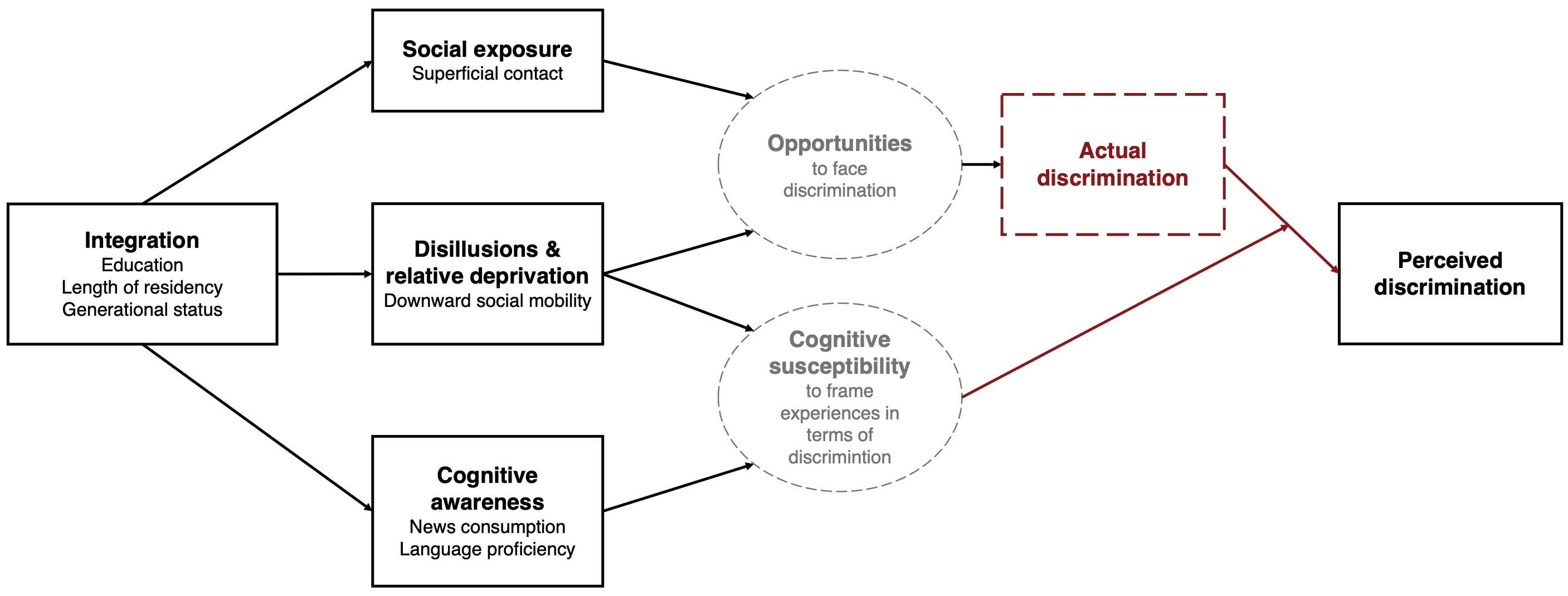
Limitation of correspondence studies
Fake CV's
have no experiences and feelings
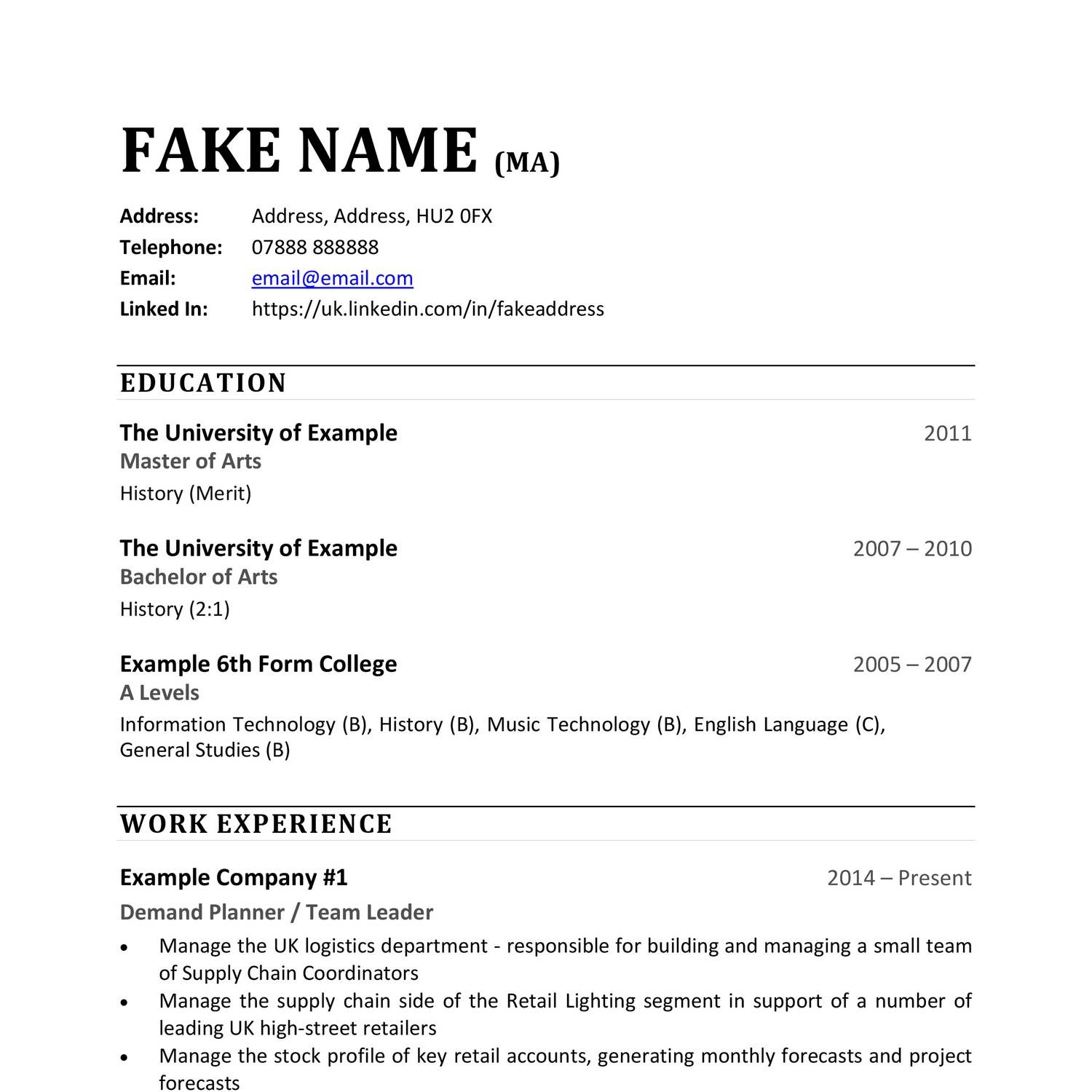

A new experimental design
The Trust game
Two persons' mutual evaluation of their trustworthiness
We'll have endowments of €10
Respondents will play both roles & we define actual role randomly afterwards

A new experimental design
The Trust game
Two persons' mutual evaluation of their trustworthiness
We'll have endowments of €10
Respondents will play both roles & we define actual role randomly afterwards

Non-anonymous games
Profile photo & spoken sentence

Actual discrimination
Non-anonymous games
Profile photo & spoken sentence

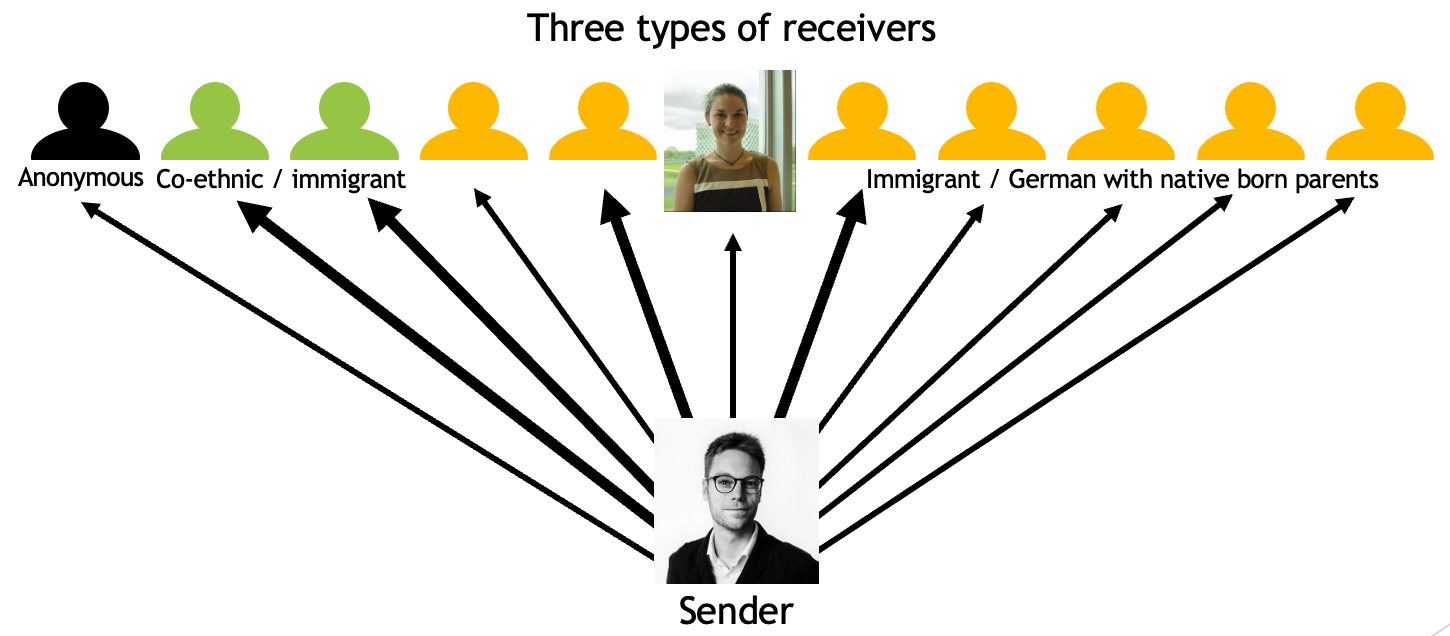
- €_{\text{Judith}} - \bar{€}_{\text{Co-ethnics}}, or €_{\text{Judith}} - €_{\text{anonymous}}
- Single measure: May be ethnic or not.
- Aggregated across 10 game partners: Ethnic discrimination.
- After all 11 games: Which two of the overall ten (non-anonymous) games do you want to have paid out?
Expected & perceived discrimination
Non-anonymous games
Profile photo & spoken sentence

Expected discrimination After all games are played: What do you think,
- Expected \Delta€ (incentivized, €4 for correct guess)
- how much did that game partner send you? \rightarrow €3
- how much did that game partner send other players? \rightarrow €5
- why did that game partner send you €2 less than the others?
- Do you think, that game partner chose your game as one of the two that are being paid out (incentivized, €2 for correct guess)
Perceived discrimination Three months later, respondents are informed about their aggregate personal and overall average payoffs.
- Why did you make less / more?
Implementation in three steps
1) Pre-game online survey
May 2021
- Photo & recorded sentence.
- Berlin, Hamburg, Cologne, Frankfurt, Munich.
- 1,500 Germans with native-born parents.
- 900 immigrants or children of immigrants.
- 600 Turkish immigrants or children of Turkish immigrants.
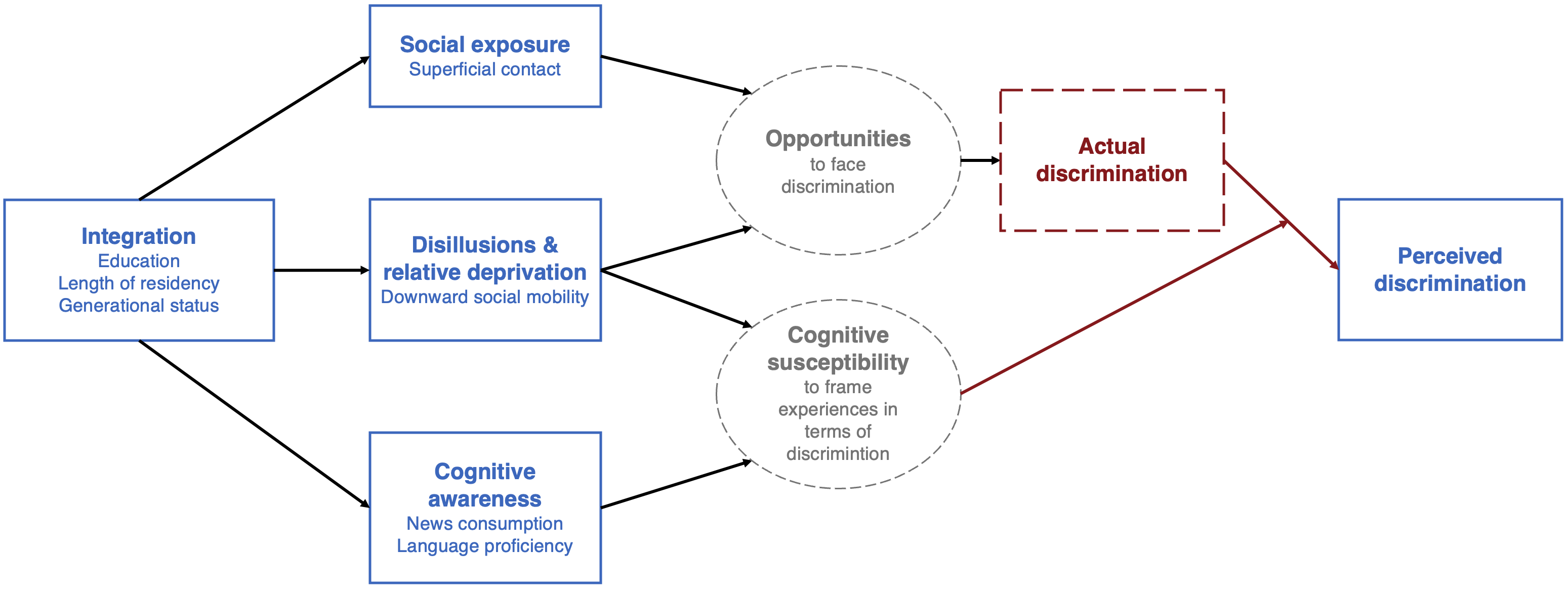
Implementation in three steps
2) Online trust games
October 2021
- n = 2,000.
- Not simultaneously but strategy method.
- Guaranteed €20, Average win €60, maximum €100.
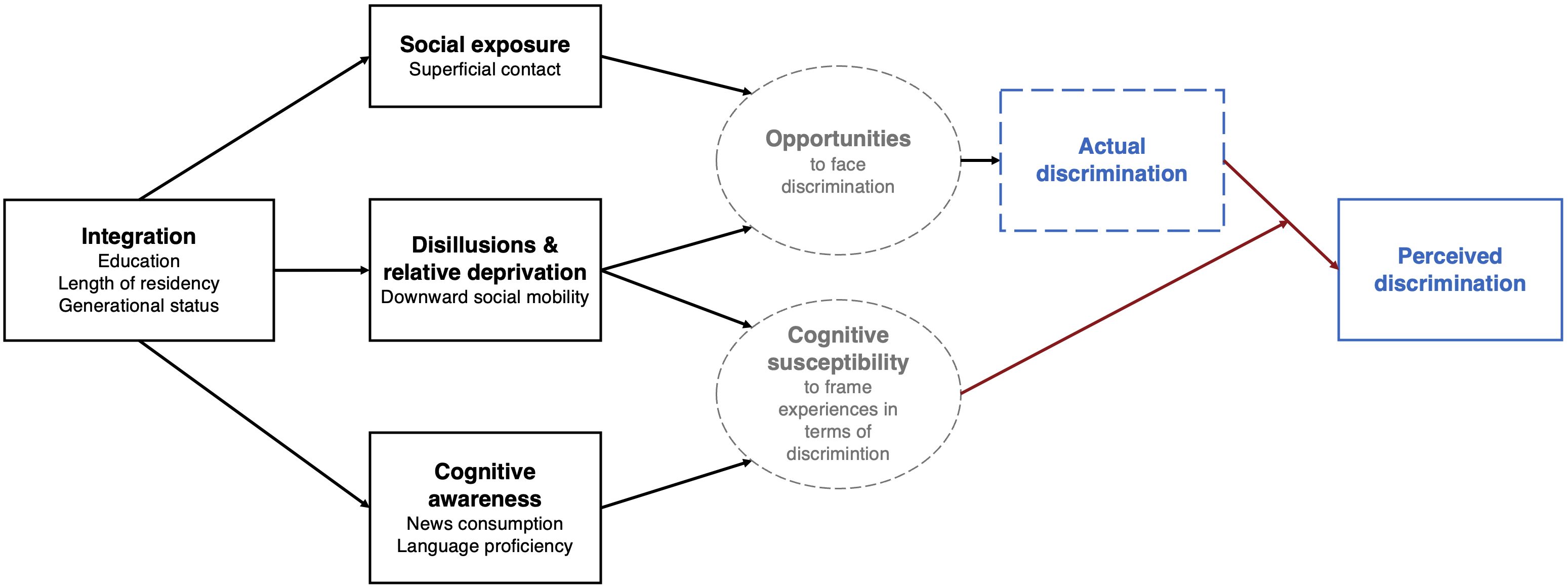
Implementation in three steps
3) Final survey
January 2022
- Information about personal and overall payoffs.
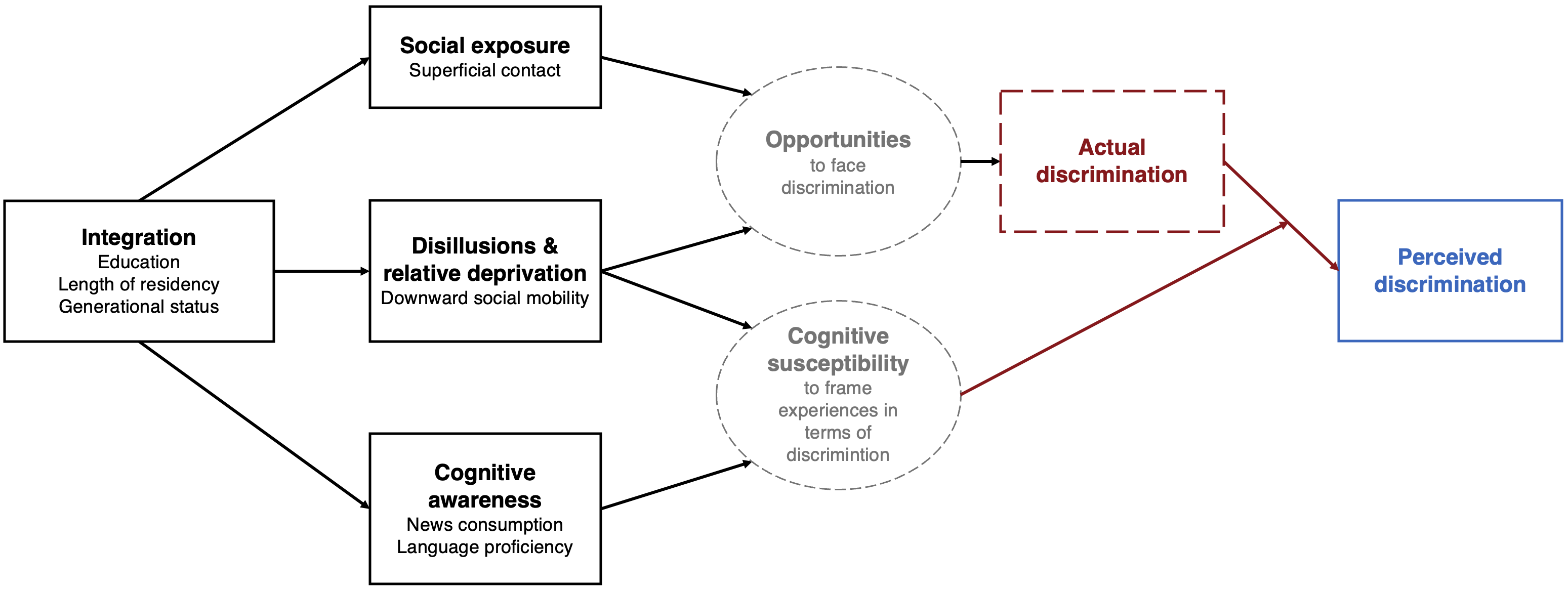
Envisioned data n = 1,500 X 8 = 12,000
| Minority | Pot. discriminator | €_{i} - \bar{€}_{j(\text{Co-ethnics})} | Exp. \Delta_i€ | j selected i | i exp. selection | i Education | i ... |
|---|---|---|---|---|---|---|---|
| i=1 (Judith) | j=1 (Merlin) | -3 | -5 | 0 | 0 | ... | ... |
| i=1 (Judith) | j=2 | 0 | 0 | 1 | 0 | ... | ... |
| i=1 (Judith) | j=3 | 1 | 0 | 1 | 0 | ... | ... |
| i=1 (Judith) | j=4 | -1 | 0 | 1 | 1 | ... | ... |
| i=1 (Judith) | j=5 | -2 | 0 | 1 | 0 | ... | ... |
| i=1 (Judith) | j=6 | -4 | 0 | 1 | 0 | ... | ... |
| i=1 (Judith) | j=7 | 3 | 0 | 0 | 0 | ... | ... |
| i=1 (Judith) | j=8 | 0 | 0 | 0 | 0 | ... | ... |
| i=2 | j=1 (Merlin) | ... | ... | ... | ... | ... | ... |
| i=2 | j=4 | ... | ... | ... | ... | ... | ... |
| i=2 | j=9 | ... | ... | ... | ... | ... | ... |
| i=2 | j=10 | ... | ... | ... | ... | ... | ... |
Conclusion
- Tocqueville's / integration paradox:
- Interesting phenomenon & maybe rather pervasive.
- Related to (Marxist) claims about false consciousness.
- Hefty implications for interview/survey based reports.
- No good toolbox to study these phenomena.
- Training pre-reg (multilevel) meta-analysis:
- Interesting tool for sociology despite violated assumptions?
- Integration paradox seems credible.
- The new experimental design:
- Artificial, but first attempt to measure & predict individuals' under- and over-perceived discrimination.
- Mis-perceptions may also be used as predictor, e.g. of political mobilization.
Conclusion
- Tocqueville's / integration paradox:
- Interesting phenomenon & maybe rather pervasive.
- Related to (Marxist) claims about false consciousness.
- Hefty implications for interview/survey based reports.
- No good toolbox to study these phenomena.
- Training pre-reg (multilevel) meta-analysis:
- Interesting tool for sociology despite violated assumptions?
- Integration paradox seems credible.
- The new experimental design:
- Artificial, but first attempt to measure & predict individuals' under- and over-perceived discrimination.
- Mis-perceptions may also be used as predictor, e.g. of political mobilization.
Thank you for your attention!
References
European Union Agency for Fundamental Rights. (2014). Violence against women :an EU wide survey : results at a glance. LU: Publications Office.
Gustafson, R. L. (1961). "Partial Correlations in Regression Computations". In: Journal of the American Statistical Association, pp. 363-367.
Konstantopoulos, S. (2011). "Fixed effects and variance components estimation in three-level meta-analysis". In: Research Synthesis Methods, pp. 61-76.
Portes, A., R. N. Parker, and J. A. Cobas (1980). "Assimilation or Consciousness". In: Social Forces, pp. 200-224.
Tocqueville, A. d. (2015). Democracy in America - Vol. I. and II. Read Books Ltd.
Viechtbauer, W. (2010). "Conducting Meta-Analyses in R with the metafor Package". In: Journal of Statistical Software, pp. 1-48.
Appendix
Which social / psychological process?
## Sample definitionsample_3 <- meta_data %>% # Only broad integration indicators and full samples. filter(pred == "Social exposure" | pred == "Labor market attainment" | pred == "Cognitive awareness" | pred == "Disillusion") %>% # Within each independent sample & type of predictor, group_by(study_ID, data, context, pred) %>% # Use sub-sample if available, filter(full_sample_num == max(full_sample_num, na.rm = TRUE)) %>% # Use model with least number of mediators filter(nr_mediators == min(nr_mediators)) %>% # Use model with min number of bad controls filter(nr_bad_controls == min(nr_bad_controls)) %>% # Use model with max number of good controls filter(nr_good_controls == max(nr_good_controls)) %>% # Use model with minimum number of integration predictors # filter(nr_preds == min(nr_preds)) %>% ungroup()Note: n = 34 partial correlation coefficients based on five coded studies and five different data sets.
Small-sample publication bias? Trim and fill analysis

Note: Results are based on (multilevel, Original model) random effects meta analyses.